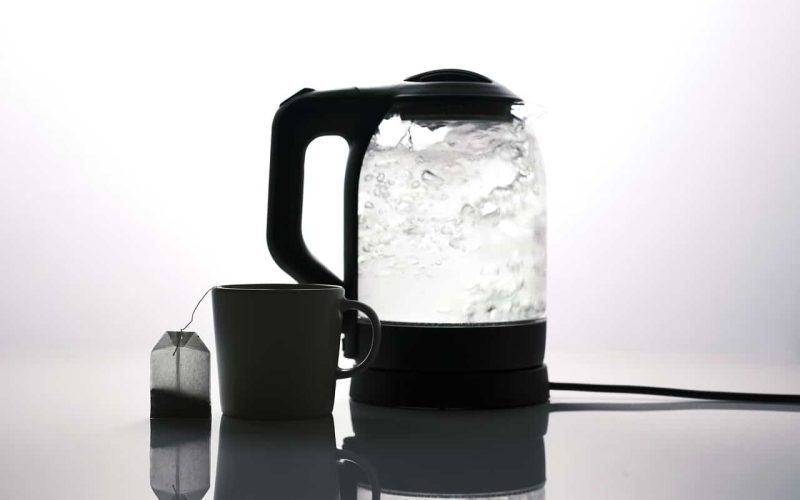Electric kettles are indispensable appliances in many households today. They make boiling water for tea, coffee, instant noodles, and other hot beverages and dishes effortless.
However, talking about their convenience, It is simple to ignore a crucial component of kettle ownership: how to clean them.
Cleaning an electric kettle is a straightforward process that helps maintain its performance and ensures the beverages taste fresh.
Neglecting the maintenance of your electric kettle can lead to decreased efficiency, problems such as foul-tasting drinks, and even potential health concerns.
In this article, we will delve into the step-by-step guidelines and advice on how to clean electric kettles to keep them free from scale buildup.
Regular cleaning ensures that your kettle continues to function optimally and safeguards your health by preventing the accumulation of limescale and mineral deposits.
If you’ve ever wondered how to banish stubborn stains, eliminate that unpleasant taste, and keep your electric kettle running smoothly, this article is for you.
Let’s embark on this journey to discover the secrets of maintaining a sparkling, clean, and efficient electric kettle. Let’s then dive in!
Understanding Your Electric Kettle
Before beginning the cleaning process, it is crucial to comprehend how an electric kettle works and the various components that make up this appliance to know how to clean an electric kettle.
The Anatomy of an Electric Kettle
1. The Base
The base connects the electric kettle to the power source. The base contains the heating element responsible for heating the water.
2. The Body
The central part of the kettle is the body, often made of stainless steel, glass, or even plastic. It houses the water reservoir and heating element.
3. The Lid
The lid is the covering of the kettle; it covers the top of the kettle and is essential for safety and preventing spills.
It is also necessary for safety. Lids should be removable for easy cleaning.
4. The Spout
Water is often poured from the spout, and some electric kettles often feature filters at the spout to catch any impurities.
5. The Handle
The handle is where you hold the kettle, allowing you to pour hot water safely.
Materials Required on How to Clean Electric Kettles
Before beginning, assemble the essential supplies and tools for your electric kettle cleaning journey.
Having these items handy will make the process smoother and more effective:
1. White Vinegar
The great natural cleanser and descaler white vinegar can keep your electric kettles sparkling clean.
2. Water
Water is an essential material for rinsing and creating a vinegar solution.
3. Soft Brush or Cloth
The interior and exterior of the kettle need to be cleaned. Set up a non-abrasive brush or towel to scrub the interior and exterior parts of the kettle.
4. Mild Dish Soap
The soap helps give the kettle a final rinse, gives it a pleasant scent, and keeps it sparkling clean.
5. Baking Soda (Optional)
Baking soda is a must-have for every home. The all-rounder, from using it to bake to using it as a cleaning agent.
Baking soda can aid in removing stubborn stains if vinegar alone is insufficient.
6. Lemon Juice (Optional)
Lemon juice provides a pleasant scent and additional cleaning power. Adding a small amount of lemon juice can help keep the kettle scent fresh all the time.
7. Kettle Descaler (Optional)
For a commercial descaling solution, use a kettle descaler as an alternative to vinegar.
Getting these materials ready ensures that you are well-prepared for the cleaning process.
Now, let’s proceed with the step-by-step guide on how to clean electric kettles.
Step-by-Step Guide on How to Clean Electric Kettles
Cleaning your electric kettle may seem impossible and daunting, considering how some kettles are made.
Do not fret; with this comprehensive step-by-step guide, you will find out that it is a straightforward process that can help extend the life of your appliance and maintain the purity of your hot beverages.
1. Unplug and Cool Down
Safety is our top priority; as much as we want your electric kettles to be sparkling clean, we want you to exercise caution and patience when dealing with your electric kettle.
Before cleaning your electric kettle, ensure it is unplugged and completely cool.
Attempting to clean a hot kettle can result in burns or other accidents. Allow your electric kettle to be completely cool before cleaning it.
2. Disassemble the Parts
Some electric kettles are made so that their parts can be dissembled.
If your kettle has removable parts such as a filter, spout, or lid, take them apart carefully.
This will enable you to completely clean each component and reach all the nooks and crannies of the kettle where dirt and scale can accumulate.
Make sure the parts are removed carefully to ensure easy reassembling.
3. Basic Rinse the Parts of the Kettle
Give your kettle a basic rinse. Fill it with warm water and swish it to loosen debris. Pour out the water and rinse it again.
This initial rinse aims to help remove loose particles before you get into more intensive cleaning.
4. Vinegar Solution
As mentioned earlier, the initial rinse is to remove loose debris. Now it’s time to tackle limescale and mineral deposits.
Create a solution using equal parts white vinegar and water.
Preparing your vinegar solution is an essential step in cleaning electric kettles. If your kettle has a large capacity, you may need more solutions.
That means the quantity of the solution you will prepare depends on the capacity of your kettle.
Pour the mixture into the kettle until it’s about halfway full.
5. Soaking the Kettle
Place the kettle back on the base to ensure it is secure. Turn it on and allow it to boil with the vinegar solution inside.
Once it reaches a rolling boil, switch off the kettle and allow it to cool for at least 10-20 minutes.
The soaking period allows the vinegar solution to work its magic on the scale buildup. Soaking the kettle allows the vinegar to clear up any scale buildup in the kettle.
6. Scrubbing
Scrubbing is the central part of cleaning electric kettle. If you’ve followed the steps, this part won’t be a hard nut to crack.
After soaking, scrub the kettle’s interior with a gentle brush or towel. Pay close attention to areas with stubborn stains or scale deposits.
The vinegar solution should have loosened these, making them easier to remove. If necessary, dip your brush or cloth into the vinegar solution to aid in scrubbing.
7. Rinse and Dry the Kettle
This is the last step on how to clean electric kettles. Empty the vinegar solution from the kettle and rinse it thoroughly with clean, cold water multiple times to ensure no vinegar residue remains.
Rinsing is essential to prevent any lingering vinegar taste in your hot beverages.
Once rinsed, leave the kettle to air dry completely with the lid open. Ensure there is no moisture left inside before reassembling and using it again.
The above steps can be repeated if you want to use lemon juice instead of vinegar to clean your electric kettle.
Using lemon juice to clean your electric kettle is an effective and natural alternative to vinegar.
Lemon juice removes scale and mineral deposits and leaves a pleasant citrusy scent behind.
Conclusion
Electrical appliances are meant to be kept clean and appropriately maintained.
Cleaning an electric kettle might sound like a daunting task for some people.
Some have never cleaned theirs ever since they bought it. Maintaining clean appliances increases their lifespan.
This article explained how cleaning an electric kettle maintains its performance and longevity.
Understanding the components and the basic mechanics of your electric kettle is crucial as it sets the stage for effective cleaning and maintenance.
Cleaning is just one part of kettle maintenance. Maintaining it is another part.
By incorporating the maintenance tips mentioned earlier into your routine, you can enjoy consistently pure and clean hot water from your electric kettle, free from the unpleasant taste and efficiency issues associated with scale buildup and neglect.
Some troubleshooting tips mentioned can help promote efficient use of your kettle.
By addressing these common issues promptly and appropriately, you can ensure that your electric kettle continues to operate safely and efficiently.
Just before we go, let’s share some frequently asked questions about how to clean electric kettles.
Frequently Asked Questions
It is recommended that you clean your electric kettles regularly, especially if you have hard water. A good rule of thumb is to clean them every 1-2 months. If you notice scale buildup or an unusual taste, clean them sooner.
You can clean a plastic electric kettle with vinegar. Rinse it thoroughly afterward to remove any vinegar residue affecting your beverages’ taste.
Yes, it is safe to use commercial descaling solutions specifically designed for electric kettles. Follow the manufacturer’s instructions and ensure thorough rinsing before using the kettle for beverages.
Baking soda and water can be combined to make a paste for stubborn stains. Apply it to the stains, let it sit for a few minutes, then scrub with a soft brush or cloth. Rinse thoroughly.
It is best and advisable to use a mild, soapy solution or a glass cleaner for the exterior of your kettle. Refrain from using harsh chemicals or abrasive cleaners that could harm the body.
Do not immerse your electric kettle in water, which can damage the electrical components. Only the interior can be cleaned with water, vinegar, or lemon juice while ensuring the outside remains dry.
If your kettle imparts a metallic taste or odor, try boiling water and lemon slices (or lemon juice) in it several times. This should help neutralize any residual tastes or smells.
Yes, citric acid is an effective alternative for descaling your electric kettle. Dissolve about 1-2 tablespoons of citric acid in water, bring it to a boil, and then let it sit before rinsing thoroughly.
Be careful not to use abrasive items like steel wool or scrubbers on the kettle’s interior, as they can damage the surface. Stick to soft brushes or cloths for cleaning.
If your electric kettle continues to have issues, such as not boiling water properly or not turning on, stop using it immediately and consult the manufacturer’s customer support or seek professional repair services.
You know how to clean electric kettles, so clean that kettle today! If you find this article helpful, recommend it to your family and friends so they can learn how to clean electric kettles, too!








